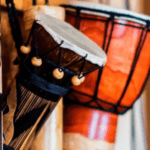Traditional Indian Music Instruments: Their Origins and Significance
- indigenousartsfoundation
- April 22, 2024

f
or decades, music has played a vital role in Indian culture. The country has a rich legacy of classical, folk, and devotional music that has fascinated listeners worldwide. A wide range of traditional Indian musical instruments, each with its own distinct history, artistry, and importance, are at the center of this musical legacy. Explore the history, development, and cultural importance of traditional Indian musical instruments in this blog post.
The Veena: Elegance in Strings
The veena is one of the world’s oldest known string instruments, having its origins in ancient India. Its elegant design includes several strings that are plucked to produce melodic tones, and a humming chamber. The veena has great cultural significance; it is a symbol of wisdom, spirituality, and the divine bond between the soul and music. It is renowned as the preferred tool of the goddess Saraswati, a symbol of knowledge and the arts, and has been honoured in Indian mythology and texts.
The Tabla: Rhythmic Heartbeat of India
The tabla is a traditional 18th-century musical instrument consisting of two tiny drums with a long history. The tabla, which has its origins in the Indian subcontinent, is played with two drums: the smaller “Dayan” melody drum and the bigger bass drum, known as the “Bayan”. Together they produce complex rhythms and patterns that serve as the foundation for Indian classical music. The tabla is more than just a musical instrument; its beats can tell tales and evoke feelings and emotions.
The Sitar: Melodic Masterpiece
One of the most well-known Indian musical instruments is the sitar, which is valued for both its complex design and unique tone. The sitar, which has its history in ancient India, has a long neck, a resonating chamber fashioned like a round object, and a set of strings that may be plunked or played to create musical tones. As a symbol of Indian classical music and cultural identity, the sitar has earned its place with its mesmerizing melodies and soul-stirring masterpieces.
“The significance of traditional Indian music instruments lies not just in their sound, but in the stories, they tell, the emotions they evoke, and the cultural connections they forge.”
The Flute: Divine Serenade
In Indian music, the flute is renowned for its beautiful melodies and calming tones. It is often linked to the divine musician Lord Krishna. The flute, which is made of bamboo or wood, makes beautiful notes that inspire peace of mind, the divine, and harmony. It represents simplicity, purity, and the enduring beauty of the natural world.
The Harmonium: Soulful Symphony
The harmonium is a popular keyboard instrument that has become an integral part of Indian music, particularly in devotional and folk genres. It dates back to the 19th century in Europe, and was brought to India by European colonists and rapidly adopted in the music of the nation. The harmonium has made its way into homes, concert halls, and temples all over India, thanks to its portable design and flexible tone, enhancing songs and attracting audiences with its emotional melody.
The instruments used in traditional Indian music are more than just means of producing tunes; they are symbols of artistic expression as well as cultural carriers. Every instrument has a legacy of expertise, creativity, and cultural significance that endured over the years of time, from the heavenly melodies of the flute to the rhythmic pulses of the tabla. We must value and protect these priceless instruments for future generations as we honour the diverse tapestry of Indian music.






